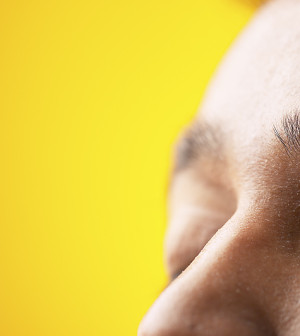- Skip Storing This Everyday Product in the Fridge Door
- Green Tea + B3 Pairing May Boost Brain Health
- Navigating Your Midlife Crisis: Embracing New Possibilities
- City Raccoons Showing Signs of Domestication
- Mapping the Exposome: Science Broadens Focus to Environmental Disease Triggers
- One Week Less on Social Media Linked to Better Mental Health
- Your Brain Changes in Stages as You Age, Study Finds
- Some Suicide Victims Show No Typical Warning Signs, Study Finds
- ByHeart Formula Faces Lawsuits After Babies Sickened With Botulism
- Switch to Vegan Diet Could Cut Your Greenhouse Gas Emissions in Half
Sleepless in the City? Nighttime Light Pollution May Be to Blame

People who live in neighborhoods that are lit up at night with neon signs and streetlights are more likely to report sleep problems, new research suggests.
Although the study doesn’t prove cause-and-effect, the scientists believe that intense outdoor illumination in the evening interferes with quality of sleep.
People with high nighttime light exposure, for example, were more likely than those in low-lit regions of the country to be dissatisfied with their sleep quantity or quality, by a margin of 13 percentage points, the findings showed.
“It was interesting for us to see how much this light in our streets was having an impact on us,” said study author Dr. Maurice Ohayon, director of the Stanford Sleep Epidemiology Research Center, in California.
The findings are to be presented in April at the American Academy of Neurology’s annual meeting in Vancouver, Canada. Research presented at meetings is typically considered preliminary until it is published in a peer-reviewed journal.
George Brainard, a professor of neurology and neuroscience at Thomas Jefferson University in Philadelphia, called the Stanford team’s analysis an “important epidemiological study.”
“Exposure to light at night can have powerful biological and behavioral consequences,” said Brainard, who also serves as director of Jefferson’s Light Research Program.
However, the associations noted in the study may be due to other factors, he cautioned.
“In an urban area, we all tend to short our sleep a lot more because it’s a busy, vibrant environment, so we’re up later at night, and maybe we’re exposed to bright light inside of our apartment or house,” he said.
“Do I think that light is part of the culprit? Absolutely, I do,” Brainard said. “Do I think this study has proven that it’s street lighting? No, I think the jury’s out on that.”
People’s sleep patterns are regulated by two systems, according to the National Sleep Foundation. The body’s natural circadian rhythm, or sleep/wake cycle, causes you to feel more alert or sleepy, depending on the time of day. And, after being awake for 16 or more hours a day, your drive to rest, called sleep/wake homeostasis, kicks in.
In addition, levels of melatonin, a sleep-promoting hormone, rise in the evening, while exposure to light delays the release of that hormone, the foundation explains.
What if outdoor lighting, such as street lights, reduces exposure to darkness?
Ohayon’s study tackles that question by plotting people’s sleep patterns against satellite data measuring nighttime light exposure.
The researchers gathered data on the sleep habits, quality of sleep, and medical and psychiatric disorders of nearly 16,000 people in telephone interviews over an eight-year period.
Using data from the Defense Meteorological Satellite Program, the team determined the amount of light people were exposed to at night.
In urban areas with more than 500,000 people, nighttime light exposure was three to six times more intense than in small towns and rural areas, the authors reported.
People with high outside light exposure slept less per night — a difference of 10 minutes a night, on average — than people with low light exposure.
Those exposed to higher light levels also were more likely to report fatigue, wake up confused during the night, and have excessive sleepiness and impaired functioning.
The study captures population-level effects of light exposure on sleep patterns by region, so it didn’t matter whether individuals closed their bedroom window shades or wore eyeshades before bedtime, Ohayon explained.
“All of that is diluted by the number of subjects that are in the area,” he said.
The only difference may have been if everyone kept the light out of their bedrooms every night, and that was not the case, he said.
Streetlights produce most of the light pollution on the planet, according to the International Dark-Sky Association, a nonprofit group that works to reduce the negative effects of artificial light, including its effects on human health.
As more cities begin to switch from yellow, incandescent lighting to blue, light-emitting diode (LED) lighting to save money, there may be implications for sleep, Ohayon suggested.
“Maybe we have to find what is the best coloration of the LED; what is the one that is preserving the safety, the security [of people], and our sleep,” he said.
For now, urban dwellers seeking a better night’s rest can remove nightlights, turn off video screens and invest in dark-out curtains, Brainard suggested.
“The darker the sleep environment, the better,” he said.
More information
The National Sleep Foundation has more on melatonin and sleep.
Source: HealthDay
Copyright © 2025 HealthDay. All rights reserved.










